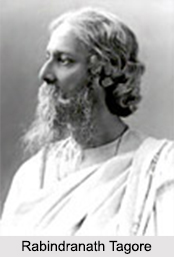 Rabindranath Tagore`s literary reputation is disproportionately influenced by regard for his poetry; however, he also wrote novels, essays, short stories, travelogues, dramas and thousands of songs. Of Tagore`s prose, his short stories are perhaps most highly regarded; indeed, he is credited with originating the Bangla-language version of the genre. His works are frequently noted for their rhythmic, optimistic and lyrical nature. However, such stories mostly were borrowed from deceptively simple subject matter - the lives of ordinary people.
Rabindranath Tagore`s literary reputation is disproportionately influenced by regard for his poetry; however, he also wrote novels, essays, short stories, travelogues, dramas and thousands of songs. Of Tagore`s prose, his short stories are perhaps most highly regarded; indeed, he is credited with originating the Bangla-language version of the genre. His works are frequently noted for their rhythmic, optimistic and lyrical nature. However, such stories mostly were borrowed from deceptively simple subject matter - the lives of ordinary people.
Literary Works of Rabindranath Tagore
Rabindranath Tagore wrote eight novels and four novellas, including "Chaturanga", "Shesher Kobita", "Char Odhay", and "Noukadubi". "Ghare Baire" (The Home and the World) through the lens of the idealistic zamindar protagonist Nikhil excoriates the rise of Indian nationalism, terrorism and religious zeal in the Swadeshi movement. In some sense, "Gora" shares the same theme, raising controversial questions regarding the Indian identity.
Another powerful story is "Yogayog" (Nexus), where the heroine Kumudini is torn between her pity for the sinking fortunes of her progressive and compassionate elder brother and his foil. In it, Tagore demonstrates his feminist leanings, using pathos to depict the plight and ultimate demise of Bengali women trapped by pregnancy, duty and family honour. He also treats the decline of Bengal`s landed oligarchy.
Other novels were more uplifting. "Shesher Kobita" is his most lyrical novel, with poems and rhythmic passages written by the main character (a poet). It also contains the elements of satire and postmodernism attacking an oppressively renowned poet who, incidentally, goes by the name of Rabindranath Tagore. Though his novels remain among the least-appreciated of his works, they have been given renewed attention via film adaptations by many directors like Satyajit Ray. These include "Chokher Bali" and "Ghare Baire"; many have soundtracks featuring selections from Tagore`s own Rabindrasangeet.
Tagore also wrote many non-fiction books, writing on topics ranging from Indian history to linguistics. In addition to autobiographical works, his travelogues, essays, and lectures were compiled into several volumes, including "Iurop Jatrir Patro" (Letters from Europe) and "Manusher Dhormo" (The Religion of Man).
Other Literary Achievements of Rabindranath Tagore
Some of his literary achievements are as follows:
•In 1890, while on a visit to his ancestral estate in Shelaidaha, his collection of poems, "Manasi", was released. The period between 1891 and 1895 he authored a massive three volume collection of short stories, "Galpaguchchha".
•In 1901, he moved to Shantiniketan, where he composed "Naivedya", published in 1901 and "Kheya", published in 1906. By then, several of his works were published and he had gained immense popularity among Bengali readers.
•In 1912, he went to England and took a sheaf of his translated works with him. There he introduced his works to some of the prominent writers of that era, including William Butler Yeats, Ezra Pound, Robert Bridges, Ernest Rhys, and Thomas Sturge Moore.
•From May 1916 to April 1917, he stayed in Japan and the U.S. where he delivered lectures on "Nationalism" and on Personality".
•In 1920s and 1930s, he travelled extensively around the world; visiting Latin America, Europe and South-east Asia. During his extensive tours, he earned a cult following and endless admirers.
Achievements Given to Rabindranath Tagore
Rabindranath Tagore was given the following recognitions for his literary works:
•For his momentous and revolutionary literary works, Tagore was honored with the Nobel Prize in Literature on 14 November 1913.
•He was also conferred knighthood in 1915, which he renounced in 1919 after the Jallianwallah Bagh carnage.
•In 1940, Oxford University awarded him with a Doctorate of Literature in a special ceremony arranged at Shantiniketan.













